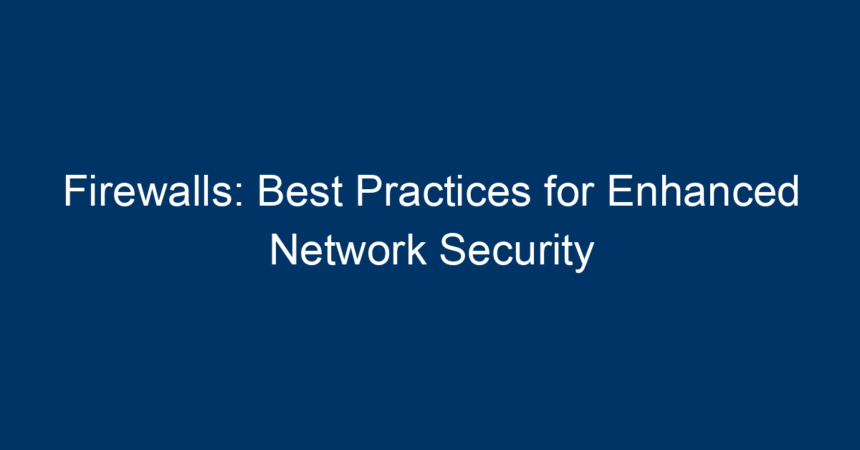In today’s digital landscape, cyber threats lurk around every corner, making robust network security a top priority for businesses and individuals alike. Central to protecting sensitive data and maintaining the integrity of a network is the implementation of firewalls. These essential security devices or software solutions act as a barrier between a trusted internal network and untrusted external data. With the rise in complex cyber-attacks, understanding the best practices for configuring and maintaining firewalls is vital. In this article, we’ll delve into the best practices for optimizing firewall performance and ensuring enhanced network security.
Understanding Firewalls
What Are Firewalls?
Firewalls serve as the first line of defense in network security. By monitoring incoming and outgoing traffic, they determine which data packets to allow or block based on predefined security rules. Firewalls can be hardware-based, software-based, or a combination of both. Hardware firewalls are typically used by businesses for the protection of entire networks, while software firewalls are often installed on individual devices.
Types of Firewalls
- Packet-Filtering Firewalls: These examine packets in isolation against predefined rules.
- Stateful Inspection Firewalls: They keep track of the state of active connections and determine which packets to allow based on the connection state.
- Proxy Firewalls: Acting as intermediaries, they filter traffic between two networks.
- Next-Generation Firewalls (NGFWs): These combine traditional firewall features with additional security functions, such as deep packet inspection, intrusion prevention systems, and application awareness.
Best Practices for Firewall Security
1. Establish a Clear Firewall Policy
A well-defined firewall policy is key to effective security management. Organizations should document their security objectives, outlining what types of traffic are permitted or denied. This includes defining access control lists (ACLs) and specifying user roles.
- Regular Review: Periodically review and update the policy to adapt to emerging threats and changes in organizational structure.
2. Enable Logging and Monitoring
To gauge the effectiveness of a firewall, it is essential to enable logging features. This allows administrators to monitor traffic, track unauthorized access attempts, and identify potential threats.
- Utilize SIEM Solutions: Security Information and Event Management (SIEM) tools can consolidate and analyze logs, providing valuable insights for incident response.
3. Conduct Regular Audits and Assessments
Regular security audits ensure ongoing compliance with industry standards and best practices. Conduct risk assessments to identify vulnerabilities and adjust the firewall configuration accordingly.
- Use Penetration Testing: Employ penetration testing to simulate attacks and evaluate the security posture of your firewalls.
4. Keep Firmware and Software Updated
Firewalls, like any software, can have vulnerabilities that hackers can exploit. Keeping firmware and software up to date is critical in protecting against known threats.
- Automate Updates: Enable automatic updates to ensure that your firewalls are always equipped with the latest security patches.
5. Configure the Firewall Correctly
Misconfigurations can create significant security gaps. Ensure that your firewall is set up to allow only necessary traffic and deny all else by default (default deny rule).
- Segment Your Network: Use firewalls to create zones, minimizing access to sensitive data to authorized users only.
6. Implement Two-Factor Authentication (2FA)
Strengthening access controls can dramatically reduce the risk of unauthorized access. Implementing two-factor authentication adds an additional layer of security.
- Enhance User Verification: Require users to provide a second form of identification, such as a code sent to their mobile device, when accessing critical systems.
7. Regularly Test Firewall Rules
Regularly testing firewall rules helps validate that security measures are working as intended. Conduct routine assessments to ensure that rules are properly configured and adjust them based on traffic patterns.
- Use Ethical Hacking: Enlist ethical hackers to evaluate the effectiveness of your firewall configurations and identify potential gaps.
Understanding Firewall Limitations
While firewalls are a crucial component of a comprehensive security strategy, they aren’t foolproof. Understanding their limitations can help organizations establish a layered security approach.
Common Limitations
- Insider Threats: Firewalls aren’t effective against threats originating from within the network.
- Encrypted Traffic: Many firewalls struggle to inspect encrypted traffic, making it essential to implement SSL/TLS inspection where appropriate.
- Application-Level Threats: Firewalls might not protect against vulnerabilities found in applications themselves.
Layering Security: Beyond Firewalls
To ensure holistic protection, it’s important to layer other security measures alongside firewalls. Consider deploying:
- Intrusion Detection and Prevention Systems (IDPS): To detect and act upon suspicious activities.
- Antivirus and Anti-Malware Solutions: To protect endpoints from malicious software.
- Virtual Private Networks (VPNs): To secure remote connections and encrypt data in transit.
Conclusion: Actionable Insights for Enhanced Security
In today’s increasingly complex cyber environment, firewalls remain a cornerstone of network security. However, understanding and implementing best practices is essential for maximizing their effectiveness. Here’s a quick recap of actionable insights:
- Develop a comprehensive firewall policy that outlines security objectives and access levels.
- Enable logging and monitoring to identify suspicious activities and maintain compliance.
- Conduct regular audits and risk assessments to adapt to new threats.
- Keep all firewall software updated to defend against vulnerabilities effectively.
- Configure your firewalls correctly, applying the principle of least privilege.
- Implement two-factor authentication to reduce unauthorized access risks.
- Regularly test your firewall rules and configurations for effectiveness.
- Layer additional security measures, including IDPS and VPNs, to create a more robust defense.
By following these best practices, organizations can significantly enhance their network security posture and safeguard against evolving cybersecurity threats. Embedding a culture of security awareness across the organization, along with adherence to these practices, is not just a necessity—it’s a prerequisite for resilience in today’s digital landscape.




